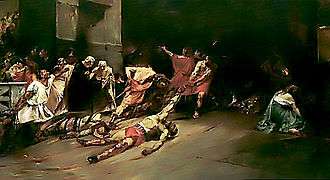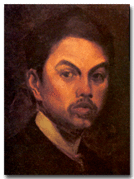Spoliarium
 | |
| Artist | Juan Luna |
|---|---|
| Year | 1884 |
| Medium | Oil on canvas |
| Dimensions | 422 cm × 767.5 cm (166 in × 302.2 in) |
| Location | National Museum of Fine Arts |
The Spoliarium (often misspelled Spolarium) is a painting by Filipino artist Juan Luna. The painting was submitted by Luna to the Exposición Nacional de Bellas Artes in 1884 in Madrid, where it garnered the first gold medal (out of three). In 1886, it was sold to the Diputación Provincial de Barcelona for 20,000 pesetas. It currently hangs in the main gallery at the ground floor of the National Museum of Fine Arts, and is the first work of art that greets visitors upon entry into the museum. The picture recreates a scene in a despoiling, a place in a Roman circus where killed gladiators are stripped of weapons and garments.

When Slaves Triumph Over Their Rulers
Juan Luna spent eight months to finish this painting, on a canvas depicting dying gladiators. Ambeth Ocampo wrote, "...the fact remains that when Luna and Félix Resurrección Hidalgo won the top awards in the Madrid Exposition of 1884, they proved to the world that indios could, despite their supposed barbarian race, paint better than the Spaniards who colonized them." (Ambeth R. Ocampo, "Rizal Without the Overcoat" 2000) .
Jose Rizal's Heart on the Spoliarium
At a gathering of the Filipino expatriates in Madrid, Spain, Rizal enthusiastically gave his opening toast to celebrate the momentous "fresh proof of racial equality" the triumphs of two compatriots (the other one was Félix Hidalgo who won a silver medal) had achieved.[1]
"Luna's Spoliarium with its bloody carcasses of slave gladiators being dragged away from the arena where they had entertained their Roman oppressors with their lives...stripped to satisfy the lewd contempt of their Roman persecutors with their honor...."[2] Rizal was footnoted in his speech that the Spoliarium, "embodied the essence of our social, moral and political life: humanity in severe ordeal, humanity unredeemed, reason and idealism in open struggle with prejudice, fanaticism and injustice."[2]
Rizal was inspired to carve a mark of his own to give glory to his country by writing his 'Spoliarium' since early that year 1884 "he had been toying with the idea of a book" for he has seen and described the painting as "the tumult of the crowd, the shouts of slaves, the metallic clatter of dead men's armor, the sobs of orphans, the murmured prayers...." Rizal's book would be called Noli Me Tangere, "the Latin echo of the Spoliarium".[3]
In popular culture
Ryan Cayabyab composed the opera Spoliarium, which chronicles the creation of the eponymous painting and Juan Luna's trial for the murder of his wife. Soprano Fides Cuyugan-Asensio wrote the libretto. A recorded version was released for commercial distribution in 2006.
Popular Filipino rock band Eraserheads had a single entitled Spoliarium in their album Sticker Happy, penned by Ely Buendia.
The painting is also mentioned by the poet Ma. Luisa Aguilar Igloria in her collection, Juan Luna's Revolver, and by the novelist Miguel Syjuco in his novel Ilustrado.
In the 2015 historical film Heneral Luna, a scene where soldiers drag the mutilated corpses of Antonio Luna and Paco Roman while shocked onlookers watch from a staircase closely mirrors that of Spoliarium. Antonio Luna is the younger brother of Juan Luna.
References
- ↑ Guerrero, Leon (1974). The First Filipino: A Biography of José Rizal (PDF) (5th ed.). Manila: National Historical Commission. p. 112. Retrieved 22 March 2016.
- 1 2 Guerrero 1974, p. 114.
- ↑ Guerrero 1974, p. 119-120, 122.
External links
| Wikimedia Commons has media related to Spoliarium. |
- Other paintings by Luna at flickr.com
